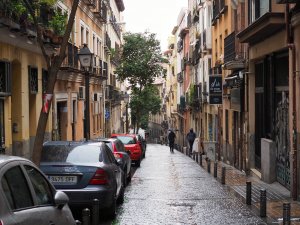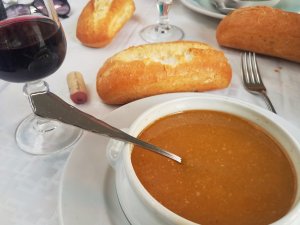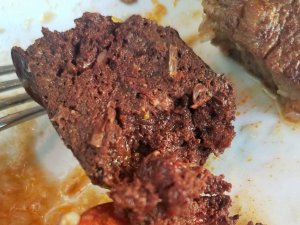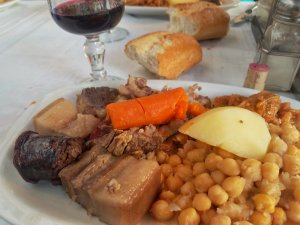Along with my usual backpacker wandering, my first trip to Spain involved a lot of typical tourist activities. My expectations for the month-long journey in Spain were low. Not that I thought the country didn’t have much to offer, but I simply didn’t know what I would do or where I would go.

Among the sightseeing, museums and old towns, one part of my month in Spain stood out the most. Above all else, Spanish food emerged as the best part of this trip.
Spain, to me, would be a place with a lot of history and culture. I expected to see a lot of old buildings and maybe wander through some photogenic little towns. From a cuisine standpoint, I honestly didn’t know much. Aside from tapas and paella, my knowledge of Spanish food was submerged in ignorance. I anticipated plenty of good wine and a lot of olive oil-based eats.
The reality of what I encountered in Spain was proven partially correct. The country does, in fact, have a tremendous amount of history and culture. And there is no shortage of old buildings and picturesque little old towns through which to wander.

The other side of my expectations, the food and drink side, was also partially correct. Spain definitely has great wine, and there is no shortage of olive oil in this country.
Where I was pleasantly – no, ecstatically – surprised was tasting just how good Spanish food is. I’ve mentioned it several times already – for instance, in these posts about food in Granada, Seville and Segovia – but the food in Spain is great, and I was so very happy to discover this that it deserves to be mentioned again.
Perhaps it is the daily samplings of jamón that just make life a little better. Perhaps the joy experienced from eating this delicacy is why Spaniards seem so laid back. Or maybe it’s the wine. Either way, food in Spain is careful and deliberate. It’s rich and steeped in tradition.

The only thing missing from Spanish food is a lack of spiciness. To be fair, although I ate everything in sight, I was only there for about a month in the southern and central part of the country. A thorough sampling of Spanish cuisine will take a few more visits, but even the occasional “spicy” option would turn out to either have no heat at all or have more of a funky whang than spiciness. That being said, the food is so good that I never really missed or craved anything spicy. It’s not necessary.
So, what is the best thing I ate in Spain? Out of more than fifty meals, did anything stand out? Oh yeah.
Of all the delicious food in Spain – all the great tapas, cakes, soups, seafood and more – one thing stands above the rest as my favorite meal in Spain: Cocido Madrileño.
What is Cocido Madrileño?
Cocido Madrileño, or simply cocido (pronounced koh-THEE-doe), is a stew. A hearty stew. It’s endemic to Madrid and beloved by locals. It is eaten year-round but is more commonly consumed in the winter.
So what makes it so special? All of it. Every bite of this hefty meal is fantastic. After two bites, with essentially the entire (large) plate remaining, I was already dreading the last bite and the moment when there would be no more.
What exactly is Cocido Madrileño? It’s a stew, yes, but there’s more. A cocido is a chickpea (garbanzo bean) stew with a lot – and I mean a lot – of meat. The meats typically include pork, pork belly, jamón, chunks of beef, usually a bit of chicken, sausage and blood sausage.

All of this is cooked in a big pot but served on a plate. It’s a big plate filled to capacity. Don’t worry about leaving hungry. Most restaurants even serve their cocido with an appetizer like soup and bread and followed by some kind of dessert. Trust me, you won’t leave hungry.

If you’re worried that it might be unhealthy, you probably aren’t much fun. Of course it’s unhealthy! But it’s fantastic. And any health concerns from all of that fatty meat are countered by the chickpeas, cabbage, a single small potato and half a carrot. Oh, and the wine. Thank the Lord for that carrot. That’s how healthy eating works, right? Right?

Okay, no, eating a cocido is not healthy, but that doesn’t mean it should be avoided. Meat in Spain is very high quality. The fat is intentional and an important part of the cuisine. It might be wise to avoid making a habit of regularly eating a cocido, but you have to try one or two.
Cocido Madrileño is an important part of Spanish cuisine. My job is traveling to eat good food, and this is one of the tastiest damn plates of food I’ve ever had. It is, by far, my favorite meal in Spain.
So how much does a Cocido Madrileño cost? All of that food has got to be expensive, right?
Not really. Food in Spain is generally very affordable. And if I’m going to label something as my favorite food or the best meal I had in Spain (or anywhere), it will probably be fairly priced. Don’t get me wrong. Fancy food is fun! Expensive doesn’t mean better, though.
A cocido is not the cheapest eat in Spain, though it’s totally reasonable. Granted, it’s a ton of food, but it will typically set you back about €15-20. Considering that’s usually the cocido, an appetizer, dessert and maybe even the wine, it’s a decent deal.
My Favorite Meal in Spain – When & Where?
Typical local restaurants in Madrid – that is, restaurants not designed to attract tourists – aren’t likely to have a cocido on the menu every day of the week. More likely, it is something that will be served once or (maybe) twice a week. The tricky part for a tourist is figuring out what day that will be. Spanish restaurants, in my experience, are not exactly consistent or dependable with their menus.

The other tricky part is making sure you find a cocido before they run out. Restaurants that only have a cocido once a week have a finite amount available. When they run out, they run out.
The good news is that, even though most restaurants won’t have a cocido on the daily menu, you can always get a fix somewhere in the city. There are a few restaurants that serve a cocido every day. Some of these may be geared toward tourists, but they aren’t likely to run out. And even a touristy cocido is going to be tasty. It just might cost a little more.
There are far more places to find a great Cocido Madrileño than this, especially unassuming neighborhood cafes and tabernas, but here are a few reliable places to find my favorite meal in Spain:
- Taberna la Daniela – a little overpriced, but they have more than one location and always have a cocido on the menu
- La Bola – a popular old standby known for its cocido
- Casa Carola – great service and large portions (even for a cocido)
- Lhardy – another cocido in a cool, albeit touristy atmosphere; busy spot near Puerta del Sol
Tips for Eating a Cocido Madrileño
- Vegetarians Beware – Sorry, veg-people! Cocido Madrileño is not for you. Truthfully, I’ve never seen a country with meat as prevalent as Spain. Sensitive veg-people might want to consider another destination before crying about all the pig legs dangling everywhere. As for a cocido, not only does it consist of heaps of meat, bone broth and blood sausage, a cocido is cooked in lard. Even the vegetables. And don’t expect to find a vegan cocido anywhere. I mean, why waste your time with that anyway?
- It’s a Late Lunch – Remember, Spaniards like to eat light breakfasts and relatively small dinners sandwiched around a large lunch. Eating a cocido is, of course, an exceptionally large lunch. That being said, lunchtime in Spain is not at noon. Typical lunch in Spain is eaten around two or three in the afternoon, so don’t expect to sit down for a cocido much earlier.
- Be Hungry – Cocido Madrileño is served in huge portions. Many restaurants even include bread and dessert. To make the most of a cocido experience, go hungry. You won’t want to be too full and risk leaving any of this deliciousness behind.
- Plan for a Siesta – We all know about the Spanish siesta, the afternoon nap. While siesta-time entails far more than an afternoon nap (and it’s actually less common in Madrid), you’ll want to block out time for some shut-eye to remedy the food coma. If you can squeeze in a short walk between cocido and siesta, you’ll be thankful later.

I love stews. Big, hearty stews. Sometimes this can be a complex creation that takes hours. Sometimes it’s a simple stew. The origin of so many stews, often from necessity, working-class people or to avoid wasting leftover ingredients, only manages to deepen my affection. Staple foods created and fine-tuned over generations fascinate me, especially when I can’t put down my fork.
Although a Cocido Madrileño doesn’t look like a stew when your hefty plate arrives, it retains all of the mouthwatering characteristics of a great stew. A cocido is the perfect meal in Madrid. It’s the best option to stuff your face before a siesta. It is uniquely Spanish, hearty and inclusive of all types/cuts of meat. Best of all, it’s one of the tastiest eats in Madrid.

My favorite meal in all of Spain happened to be the fairly simple and straightforward Cocido Madrileño. Upon my return to Spain, I’m heading straight for Madrid. You’ll find me spending my afternoons eating great food and searching for the best cocido (or two), right before a timely and necessary nap.
Leave a Reply
You must be logged in to post a comment.